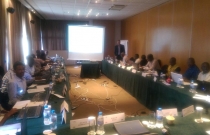Network Modelling and Load Flow Analyses – EATP Project (Part II)
08.10.2015
Within the EATP Project the three days training was provided by the EKC for experts of REG and TANESCO (Rwanda).
The training was conducted in Kigali, Rwanda from October 06th to 08th, 2015.
Day 1
- Network modelling
- Common issues detected in national LF models
- Subsystem (Area/Zones/Owners)
- Setpoints for voltage control
- 2 winding transformers (Winding1Angle, From/To windings etc.)
- Switched shunts
- Convergence issues
- Modelling of X-nodes
- 3 winding transformers
- Hands-on exercise
- Common issues detected in national LF models
- Power flow simulations
- Checking data
- Running LF simulations
- Achieving convergence of divergent cases
- Network limit violations
- Reports / Compare cases
- Inertial / Governor redispatch
- Hands-on exercise
- Basic contingency analyses
- Preparation of sub-system, monitoring, contingency and distribution-factor data files for running the automatic contingency analysis
- Running automatic contingency analysis
- Interpreting reports of contingency analysis
- Hands-on exercise
Day 2
- Advanced contingency analyses
- N-1-1 Contingency Solution
- Multi-level AC Contingency
- Tripping Simulation
- Corrective actions
- Hands-on exercise
- Running PSS/E with Automation Files (IDEV, Python) - Basic
- Load flow calculation
- Contingency analyses
- Reports
- Hands-on exercise
Day 3
- Maximum network transfer capacity
- Definition of maximum network transfer capacity
- Creation of Monitoring and contingency lists
- Calculation setup
- Calculation of maximum network transfer capacity
- Hands-on exercise
- Implementing renewable generation and simulating their effects on the grid
- Quick review of WF and PV theory
- Typical issues / Grid code requirements
- LF modelling issues in PSS/E
- Hands-on exercise
- Working with single line diagrams
- Renumber busses in Diagram
- Compare Cases on a Diagram
- Contouring Diagrams
- Working with Layers
- Hands-on exercise

